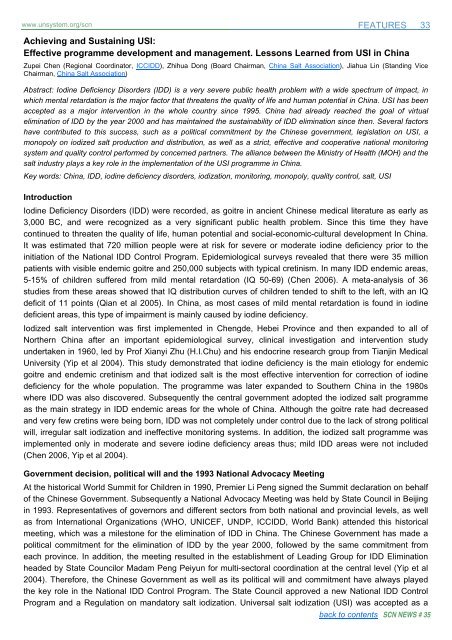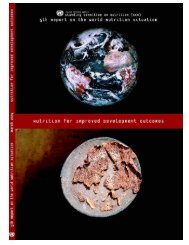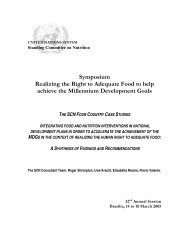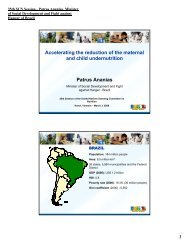Universal Salt Iodization (USI) - FTP Directory Listing
Universal Salt Iodization (USI) - FTP Directory Listing
Universal Salt Iodization (USI) - FTP Directory Listing
- No tags were found...
Create successful ePaper yourself
Turn your PDF publications into a flip-book with our unique Google optimized e-Paper software.
www.unsystem.org/scn FEATURES 33Achieving and Sustaining <strong>USI</strong>:Effective programme development and management. Lessons Learned from <strong>USI</strong> in ChinaZupei Chen (Regional Coordinator, ICCIDD), Zhihua Dong (Board Chairman, China <strong>Salt</strong> Association), Jiahua Lin (Standing ViceChairman, China <strong>Salt</strong> Association)Abstract: Iodine Deficiency Disorders (IDD) is a very severe public health problem with a wide spectrum of impact, inwhich mental retardation is the major factor that threatens the quality of life and human potential in China. <strong>USI</strong> has beenaccepted as a major intervention in the whole country since 1995. China had already reached the goal of virtualelimination of IDD by the year 2000 and has maintained the sustainability of IDD elimination since then. Several factorshave contributed to this success, such as a political commitment by the Chinese government, legislation on <strong>USI</strong>, amonopoly on iodized salt production and distribution, as well as a strict, effective and cooperative national monitoringsystem and quality control performed by concerned partners. The alliance between the Ministry of Health (MOH) and thesalt industry plays a key role in the implementation of the <strong>USI</strong> programme in China.Key words: China, IDD, iodine deficiency disorders, iodization, monitoring, monopoly, quality control, salt, <strong>USI</strong>IntroductionIodine Deficiency Disorders (IDD) were recorded, as goitre in ancient Chinese medical literature as early as3,000 BC, and were recognized as a very significant public health problem. Since this time they havecontinued to threaten the quality of life, human potential and social-economic-cultural development In China.It was estimated that 720 million people were at risk for severe or moderate iodine deficiency prior to theinitiation of the National IDD Control Program. Epidemiological surveys revealed that there were 35 millionpatients with visible endemic goitre and 250,000 subjects with typical cretinism. In many IDD endemic areas,5-15% of children suffered from mild mental retardation (IQ 50-69) (Chen 2006). A meta-analysis of 36studies from these areas showed that IQ distribution curves of children tended to shift to the left, with an IQdeficit of 11 points (Qian et al 2005). In China, as most cases of mild mental retardation is found in iodinedeficient areas, this type of impairment is mainly caused by iodine deficiency.Iodized salt intervention was first implemented in Chengde, Hebei Province and then expanded to all ofNorthern China after an important epidemiological survey, clinical investigation and intervention studyundertaken in 1960, led by Prof Xianyi Zhu (H.I.Chu) and his endocrine research group from Tianjin MedicalUniversity (Yip et al 2004). This study demonstrated that iodine deficiency is the main etiology for endemicgoitre and endemic cretinism and that iodized salt is the most effective intervention for correction of iodinedeficiency for the whole population. The programme was later expanded to Southern China in the 1980swhere IDD was also discovered. Subsequently the central government adopted the iodized salt programmeas the main strategy in IDD endemic areas for the whole of China. Although the goitre rate had decreasedand very few cretins were being born, IDD was not completely under control due to the lack of strong politicalwill, irregular salt iodization and ineffective monitoring systems. In addition, the iodized salt programme wasimplemented only in moderate and severe iodine deficiency areas thus; mild IDD areas were not included(Chen 2006, Yip et al 2004).Government decision, political will and the 1993 National Advocacy MeetingAt the historical World Summit for Children in 1990, Premier Li Peng signed the Summit declaration on behalfof the Chinese Government. Subsequently a National Advocacy Meeting was held by State Council in Beijingin 1993. Representatives of governors and different sectors from both national and provincial levels, as wellas from International Organizations (WHO, UNICEF, UNDP, ICCIDD, World Bank) attended this historicalmeeting, which was a milestone for the elimination of IDD in China. The Chinese Government has made apolitical commitment for the elimination of IDD by the year 2000, followed by the same commitment fromeach province. In addition, the meeting resulted in the establishment of Leading Group for IDD Eliminationheaded by State Councilor Madam Peng Peiyun for multi-sectoral coordination at the central level (Yip et al2004). Therefore, the Chinese Government as well as its political will and commitment have always playedthe key role in the National IDD Control Program. The State Council approved a new National IDD ControlProgram and a Regulation on mandatory salt iodization. <strong>Universal</strong> salt iodization (<strong>USI</strong>) was accepted as aback to contents SCN NEWS # 35







